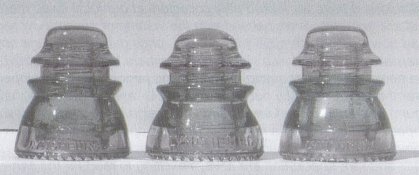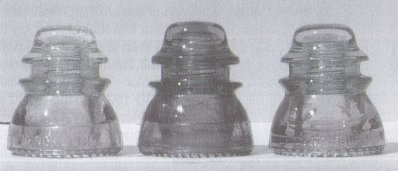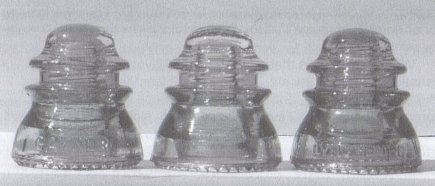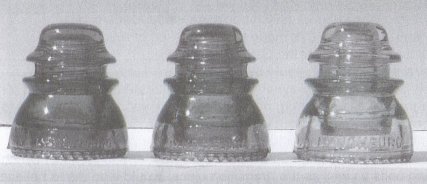Collecting For Fun
by Dennis Stewart
Reprinted from "Crown Jewels of the Wire", February 2001, page 25
This is hopefully just the first in a series of articles directed at new
collectors. I have witnessed new collectors at our local swap meets that are
generally overwhelmed with the volume of sensory overload now available through
publications, price guides, catalogs and internet auctions and web sites. We old
timers tend to talk "above" the newer collector spouting out slang and
jargon we've developed over the years. We spit out CD numbers, U- and M- numbers
that sound like some kind of secret code or foreign language. What was hoped to
be a relaxing and fun hobby can appear as tedious, complicated, and too much to
deal with. Articles on exotic new finds and rare specimens are always exciting
to read for the seasoned collector, but the newer collector may not be able to
relate to them. Hopefully, I can write these in a way that will be enjoyed by
all.
Collecting the Lynchburg 44
Despite being a collector of glass power, classic and multipart porcelain,
there is one particular railroad/telegraph style I still collect. I've always
been fond of the CD 154 Lynchburg 44. The roots of my attraction to this style
go back to my earliest days of collecting nearly thirty years ago.
It was along
the abandoned stretch of the old C&O Railroad that ran from Cincinnati to
near the Indiana line that I found my first Lynchburg 44. I had no reference
books then and had only known of Hemingray, Brookfield, H.G. Co., Whitall Tatum
and Armstrong names on glass insulators. I recall going along the line and
picking up anything that was not broken, mostly CD 152 Hemingray-40 with and
without 1893 patent date and CD 154 Hemingray-42 in aqua, blue and clear. When I
picked up what I thought was another "42", I was surprised to see the
name GAYNER in large letters on the front and MADE IN No. 44 U.S.A. on the rear.
Wow! The tingle of excitement at that moment was what it was all about. What a
strange name! Was there any end to the neat things out there?
But what, it looks like another one. It's busted up real bad, but it too says
GAYNER. Hey! There's a third one, but hold on here. It says LYNCHBURG on the
front instead of GAYNER. What in the world is going on here? The two were
identical in shape and color. The only difference was the names on the front and
the Lynchburg had a  on the very top.
on the very top.

In the center is the early, short style Lynchburg
flanked by the later,
taller styles.
The identical Gayner and Lynchburg style obviously had a connection. It was
the same general idea of the blue Hemingray 42's I had found but was somewhat
shorter and had a more rounded dome. They both had sharp drip points and seemed
to be likely contemporaries of some of the older 42's with the sharp drip
points. But why the two names on essentially the identical light aqua insulator?

Two tall Lynchburg styles on either end with
the Hemingray-42 in the center
for comparison.
I now had a mystery to solve and was in desperate need of reference material.
But before I had any there was yet another strange development. During a later
hunt further up the same line, I spotted the now familiar shape of the No. 44.
It was always fun to immediately look at the front to see whether it was a
Gayner or a Lynchburg, as there eventually seemed to be about an equal number of
both found.
But this time I was really shocked. It had the familiar MADE IN No.
44 U.S.A. on the rear, but the front was completely blank! The pieces of the
puzzle finally made sense after reading several reference sources that made the
connection of the Lynchburg company taking over the Gayner molds.
It's only a
theory, but I believe the blank front piece is a transition item where the
Gayner name was obliterated in preparation for engraving the Lynchburg name.
Perhaps it was a test specimen to see how well the blot-out was done. It was a
perfectly good insulator and was sent out with the rest of the order of engraved
units. The fact that this line had a mix of both Gayner and identical Lynchburg
units as well as the "transition piece" would lead me to believe that
Lynchburg sold the No. 44 with Gayner on it until they could get the molds
changed to their name. No other blank front was ever found before what was left
on the poles and lines one day disappeared forever. In a very strong light and
at just the right angle a very faint "outline of GAYNER" can be seen
on the blank front. Perhaps there are some Lynchburg specialists that can
elaborate on these theories.

The Gayner to Lynchburg "transition"
Left is the GAYNER - 44;
Center the "outline of GAYNER" front - 44";
Right is the
LYNCHBURG - 44
Over the years I began to realize the Lynchburg 44 was a very prolific
insulator that went far beyond the Gayner look alike. At some point it appears
the Lynchburg folks wanted their No. 44 to look more like the enormously popular
Hemingray-42. The newer units were taller and had a flatter top like the 42.
This is where the Lynchburg 44 becomes a really fun item to collect. There seems
to be a nearly endless variety of embossing variations within the sharp drip
point era and later into the round drip point variants.

Affordable color in three tall style Lynchburgs
Yellow-green. Sage and
Gingerale.
These run a wide range of colors from near clear to gingerale and ice blues
through sage and yellow greens. Sorry, no ambers or cobalts, but that's another
good thing about this item. As of the 1999 Price Guide, there were no
"jokers in the deck". There are no variations or colors where you have
to decide, "Do I buy the insulator or go on that cruise?" "Buy
the insulator or fix the roof?" "Insulator or new car?"
What is
so neat is that after nearly thirty years I can still find variations to add to
my set. In the East at least they can still be found at flea markets, antique
malls and shops mixed in with common Hemingray-42's and Whitall Tatum No. 1 's.
There are still many on the line waiting their turn to come down. There are
likely variations and embossing error and color combinations unlisted yet to be
found.
So here is an affordable and still quite accessible series to get into.
They are generally available at swap meets and shows and even the top end items
are within a realistic wish list.
Happy Collecting!
| 